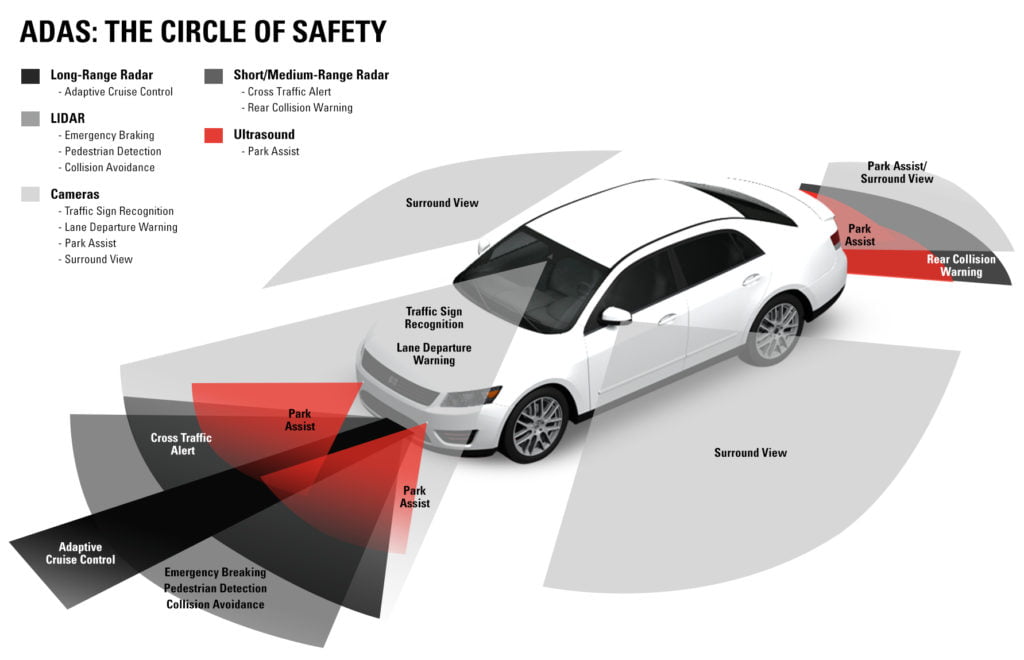We are back with yet another modern and exciting theme to discuss in this edition of the Automobile Technology Section. As usual, the aim of this section is to bring to you, the latest topics related to automobile engineering and explain the technicalities in a simple-to-understand fashion. A lot of people are car enthusiasts nowadays and want to understand the working of various components of their vehicles. We aim to achieve a sort of universal and general understanding of our readers about various automobile technologies, especially the ones which are relevant in this day and age. That is the topic for today as well. But before we start, make sure to check out Car Blog India for all the latest happenings from the world of the automobile industry and the Automobile Technology Section to read fascinating technology related to automobiles in a simple language.
Also read: Working of Hydraulic, Electric, Electrohydraulic Power Steerings!

Advanced Driver Assistance System (ADAS)
As the name suggests, this system has numerous features which assist the driver in terms of safety and convenience. Essentially, what this system consists of are additional hardware and software to process a ton of data that can be used by the vehicle to aid human efforts and decrease the chances of human errors. According to stats, most of the accidents that happen on road globally can be avoided simply if there were this ADAS in place. The main problem during an accident is that the driver fails to respond quickly enough. In such scenarios, even a slight assist from the electronics of the car can avoid the accident altogether or at least, reduce the intensity of the impact considerably. In addition to that, it has features that can help the driver to maintain a constant speed on the highway with the Adaptive Cruise Control feature or help the driver to change lanes with the Lane Departure feature.
Also read: How do ABS, EBD, ESP, Hill-Hold Assist and Traction Control work?
Advanced Driver Assistance System (ADAS) – Components
The ADAS comes in a lot of modern cars because carmakers have understood the relevance of this system. Additionally, implementing ADAS on a large scale will also bring the cost of the technology down and it can be used in cars of almost all the segments in varying degrees of sophistication. The components of this system primarily involve electronics and signal processing computing software. This means that there are various sensors, radar, lidar, signal processing software and uses the Engine Control Unit or the supercomputer on the vehicle which manages all the data and gives the necessary command signals. The sensors gather the data from the surroundings of the car and convey that to the ECU. Together with radar or lidar the more sophisticated cars even convert the data from sensors and radar into a 3D representation of the surroundings. This makes sure that the car distinguishes between various objects like a tree, potholes, moving objects and humans.
Also read: How does EGR (Exhaust Gas Recirculation) work – Principle and Advantages!
In some instances, this data also gets synchronized to the navigation system of the car. This prepares the electronics of the car for the upcoming obstacles as well. As a matter of fact, such components aid the visibility of the driver in scenarios where the driver can’t fully grasp what is happening on the road in front of him. This includes situations of low visibility during rain, snow, fog or the presence of a car ahead of you. To overtake a big truck, the driver has to be sure that there are no cars in front of the truck. The radar waves can go beyond the big truck to alert the driver if it senses a secondary vehicle on the road, which the driver would never have been able to locate. Some of the main features that use the ADAS are the following.
Also read: Camshafts and Valves – Working and Classification!
Automatic Emergency Braking
One of the most important aspects of the ADAS is automatic emergency braking. As the name suggests, the system senses the danger and realizes that the driver has failed to act quickly enough to avoid a collision. The ADAS interferes in the process and can apply the brake with complete force. Also, there have been many instances where the driver did apply the brakes but not strongly enough. He/She was not able to press the brake pedal completely which is normal under stress situations. Therefore, to assist the driver, the ADAS sends a warning signal to the driver to act. If the driver does not respond well enough, it takes control and can avoid the accidents altogether or at least, reduce its intensity.
Also read: Uses of a 48V hybrid system – Regenerative Braking, Turbo Boost, Fuel Economy and more!
This feature has multiple uses. For instance, the above-mentioned case can happen when the traffic is oncoming. But sometimes, the cars can come up from the sides as well which can take the driver by surprise. Or, there are situations in fog when the car in front of you suddenly stops and by the time the driver sees that it is already too late and you end up colliding in the back of the car in front of you. In all these scenarios, the procedure of the ADAS is the same. Sensing an imminent collision, ADAS will apply the brakes for you.
Also read: What is Air Suspension – What are Stiff and Soft Springs?
Lane Departure Warning
With the help of the sensors, camera and radar, there is a constant feed of the roads to the electronics of the vehicle. The lane markings are recorded in the car and the ADAS system monitors the blind spot for the driver on either side of the car. If the driver wants to change the lane but does not see the car in the blind spot, the car will intimate the driver through a voice signal and the driver can avoid a collision.
Also read: What are Intercoolers – Types and Functions?
Adaptive Cruise Control
Another important aspect of the ADAS to enhance the convenience of the drive is the Adaptive Cruise Control. In this, the electronics of the car keep a closed eye regarding the acceleration, braking and overall movements of the car in front of you. When you set your car to maintain a constant speed according to the car in front of you, the adaptive cruise control makes sure that it applies the brakes and accelerates the car for you depending on what the car in front of you is doing. This happens simply by processing the data gathered by the sensors and camera and sending the required signals.
Also read: What is Engine Knock – What are its consequences and how to prevent it?
Park Assist
Probably one of the most important aspects for drivers is the lack of parking skills in tight spots. This is a prevalent problem in the cities where space is less and the cars are way more. In the case of ADAS, the sensors and camera can measure the distance available for the parking upto the last inch and will guide you through the process. It will already tell you if it is possible to park the car there or not. Thereafter, it will also manage the steering for you and you would just have to follow the command of working the gear lever. This makes sure that the entire parking space is utilized without the driver having to worry at all.
Also read: What are Catalytic Converters – How do they reduce emissions?
Image Source: Robotics & Automation News


